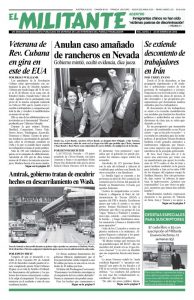Protests by working people and youth rapidly spread to 80 cities and rural towns across Iran since Dec. 28. They began amid widespread frustration and anger among working people against rising prices, high unemployment and new government budget proposals that would have eliminated many subsidies for workers.
This working-class discontent came on top of mounting dissatisfaction with policies restricting political and individual rights and exacerbating class divisions in Iran. In a budget that hiked fuel prices 50 percent — now rescinded — and slashed subsidies for workers, President Hassan Rouhani also revealed increases in the vast amounts lavished on religious institutions that function as businesses filling the pockets of wealthy members of the ruling hierarchy.
The New York Times Jan. 2 cited a video interview with a protester who supported the 1979 revolution against the U.S.-backed shah of Iran and who himself was a veteran of Iran’s defensive war in the 1980s to stop U.S.-backed attacks by the Iraqi regime of Saddam Hussein. What he is protesting today, he said, is “bribery, injustice, embezzlement. Who is accountable? Those living in palaces, ministers who have never been hungry.”
Protesters also raised demands against Tehran’s wars in Syria, Iraq and Yemen and its backing for Hezbollah and Hamas. These military conflicts, involving Washington and Moscow as well as Tehran, have had a devastating impact on working people. The human costs and consequences are class differentiated — largely unseen by Iranians in better-off middle-class areas — while signs and monuments to the martyrs are a mainstay in workers’ neighborhoods and towns.
Supported by Moscow’s air power, Iran’s Revolutionary Guard forces and Tehran-backed militias pushed back the Syrian people’s struggle to overturn the Bashar al-Assad dictatorship and to win more political space. They have also dealt blows in recent months to Kurdish aspirations for independence in Iraq.
On Dec. 29 some protesters chanted, “Reformists! Hardliners! The game is over!” urging an end to rule by both wings of the clerical regime, which consolidated capitalist rule in a counterrevolution against the deep-going 1979 revolution. That popular uprising, spearheaded by working people and reinforced by countrywide working-class strikes, forced the hated monarch, the shah, to flee Iran. The revolutionary upsurge was broken when the clerical regime used increasing repression in order to counter independent political action by workers and peasants.
The clerical regime falsely rationalizes its wars today as the continuity of the 1979 revolution. In reality, today’s conflicts are aimed at extending the counterrevolutionary influence of Iran’s capitalist rulers across the region, establishing a land bridge linking the regime with its Hezbollah allies in Lebanon, and ensuring Tehran access to the Mediterranean.
None of this is in the interests of working people in Iran, much less anywhere else in the region.
Arrests and killings
Both wings of the regime — represented by Rouhani, on the one hand, and Supreme Leader Ayatollah Ali Khamenei, on the other — give lip service to the right of Iranians to peacefully protest “legitimate” grievances. At the same time, Iran’s rulers have slandered working-class protesters as “saboteurs,” claiming their actions have been instigated by Iran’s “enemies” in Washington, Tel Aviv, Saudi Arabia and the Kurdistan Regional Government in Iraq.
What’s more, both governing factions are wagging fingers at former Iranian President Mahmoud Ahmadinejad, whose base among working people and worse-off middle layers in smaller cities and towns has been a center of the recent discontent.
Above all, Iran’s rulers have joined in bringing down repressive measures against demonstrators. The regime has arrested nearly 3,700 people, mostly young, according to parliament member Mahmoud Sadeghi, and more than 20 have been killed. The regime shut down parts of the internet to block communication.
The government and its supporters mobilized actions backing Ayatollah Khamenei. The Revolutionary Guard deployed troops to three of Iran’s provinces to quell protests. Maj. Gen. Mohammed Ali Jafari, head of the Revolutionary Guard, declared the defeat of the “sedition.” The regime’s moves, combined with the lack of any disciplined leadership of the actions, have led to a decline in large street protests.
On Jan. 5 thousands of fans in Tabriz, in Iran’s East Azerbaijan province, stood during a soccer match and chanted, “People of Azerbaijan won’t accept humiliation!” A video of the protest was posted on the internet. On Jan. 7, over 100 people gathered outside Evin prison in Tehran to demand the release of protesters.
The widespread discontent within the working class that fueled the unrest continues to percolate.
Washington, the biggest military power in the Mideast, is concerned that Tehran’s gains threaten U.S. imperialist interests in the Middle East. It demagogically poses as a supporter of Iranian protests. Washington pushed for an emergency U.N. Security Council meeting Jan. 5. But the capitalist rulers of most other nations were wary that a U.N. resolution could backfire, deepening struggles by working people in Iran.
Tehran’s Saudi rivals have not backed the protests challenging the Iranian government. “While they are on opposite sides in regional conflicts, Iran and Saudi authorities share a low tolerance for domestic dissent,” the Wall Street Journal wrote Jan. 5.

